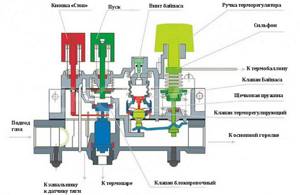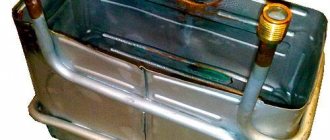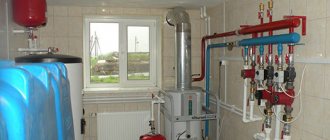Home / Boiler automation
Back
Published: 05/14/2019
Reading time: 3 min
1
1135
We have long forgotten what stove heating is, when in order to heat the room it is necessary to take part in lighting the stove. Modern heating units used in everyday life can operate on gas, which is supplied in pipelines or delivered in cylinders. In this case, there is no need to systematically monitor ongoing operations; the fundamental principle of automation allows all actions to be carried out autonomously.
The process of combustion and maintaining the temperature of the coolant is ensured using various elements, which can be mechanical and electrical.
They are built into the equipment of floor-standing boilers at the manufacturing stage and provide completely autonomous operation. Automation designed for a gas boiler operates according to a certain principle that ensures a closed cycle.
- 1 Basic functions of boiler safety automation
- 2 Varieties
- 3 Design of devices and description of the principle of their operation 3.1 Mechanical sensors
- 3.2 Electronic devices
How does a gas boiler work?
The principle of operation of a gas heating boiler can be described in the most general terms as follows: the heat generated by the combustion of gas is transferred to a liquid, which then moves through the heating system, heating the room.
The design of any gas heating device usually involves the presence of several main components:
- Burner;
- Heat exchanger;
- Expansion tank;
- Gas valve;
- Automation system.
The specifics of a double-circuit boiler often suggest some features of its internal structure. For example, many models are equipped with two heat exchangers, each of which is responsible for heating “its own” area. In addition, a dual-circuit unit always has a special three-way valve that switches its operating modes (from heating to hot water supply and vice versa).
Burner
This is a rectangular structure with holes arranged in a certain order through which gas is supplied from the nozzles located below. Depending on the type and performance, a gas boiler can be equipped with two types of burners:
- Atmospheric
. Gas is supplied to the combustion chamber solely due to pressure in the line. This burner operates almost silently and costs less, so it is used more often, but its efficiency usually does not exceed 90%; - Supercharged
. The principle of its operation is different - air is supplied to the combustion chamber using a fan. Typically, such burners are not built into the gas path, but are installed using a special external connection. Their main advantages are higher efficiency and stable operation with unstable gas supply.
Based on the ability to adjust the power of the burners, they are divided into three classes:
- Single-stage
- the flame always burns the same way. It is clear that this negatively affects both the service life and the efficiency of the device; - Two-stage
. These burners are a little better. They allow you to use the unit in two modes: 50 and 100% power; - Modulated
. There is a built-in smooth power control circuit over a wide range. A gas boiler with such a burner will be as economical as possible and will last longer than others.
Heat exchanger
As we have already noted, a double-circuit boiler can use one or two heat exchangers.
The scheme with two heat exchangers involves installing a primary device in the form of copper pipes with plate fins directly above the burner. This design principle allows the heat of the gas flame to be transferred directly to the coolant with maximum efficiency. The secondary heat exchanger is usually made in the form of a set of thin metal plates, passing through which running water is heated by the hot coolant.
If a heating boiler uses a single heat exchanger, it is called bithermic and is a structure of two coaxial pipes. Plumbing water passes through the inner pipe, and the outer surface heats the coolant.
The advantages of connecting two heat exchangers for a double-circuit boiler are quite obvious:
- If the secondary heat exchanger fails, the gas boiler continues to operate in heating mode;
- The primary heat exchanger is not subject to excessive corrosion due to the constantly changing composition of the circulating fluid;
- Installing a secondary heat exchanger when it fails is much simpler and cheaper than replacing the entire bithermic one.
Expansion tank
When the coolant is heated, it expands and increases in volume. In view of this, the heating circuit must provide a special container into which excess liquid will be drained. Typically, the required tank size can be estimated as 10% of the total coolant volume in the system. Sometimes a situation may arise when the built-in tank is not enough, and an external one will need to be installed.
Gas valve
The presence of a gas valve is a prerequisite for connecting the system to the main gas. It regulates the degree of fuel supply, and it is controlled by an automation circuit. In the event of any breakdowns, the gas supply to the double-circuit boiler is immediately turned off.
Automation system
The circuit for automatic control of the operating modes of a double-circuit thermal unit is a set of sensors that analyze the state of nodes and connections to the input and output routes, and an actuator that generates the necessary control signals:
- Temperature sensors (the modulating burner is adjusted according to their readings);
- Gas block sensors - monitor the pressure in the fuel line;
- Power supply sensors - turn the boiler on and off during power outages.
- Self-diagnostic tools.
Automation elements
Maintaining optimal boiler operation and equipment safety have long depended not on the human factor, but on the automation that comes with gas equipment. It can be volatile, more reliable, but requiring the presence of an uninterruptible power supply, and non-volatile (mechanical), characterized by autonomy and simple design. The security system can consist only of the necessary elements or be multifunctional, have manual control or a programmer.
Automation ensures reliable and economical operation of the gas boiler without human intervention.

Non-volatile system
Such automation is attractive due to its isolation from electricity, low cost and maintainability. The operating temperature range that affects the operation of the thermostat is set here manually using a switch connected to the thermostat built into the boiler. Its design contains a rod made of a material that can shorten and lengthen as the temperature of the coolant changes. As a result, the gas supply valve opens or closes, completely cutting off the flow of fuel to the burner.
The set of non-volatile automation also includes flame and draft sensors. If the burner suddenly extinguishes, as well as with a significant decrease in draft, the gas is instantly shut off. But for comfortable and economical operation of modern boilers, the above options are not enough. Manual regulation does not make it possible to use the equipment in optimal modes, so savings, comfort and service life of the boiler without additional automation are reduced to a minimum.
Volatile system
Maximum ease of operation of gas heating appliances is ensured by electronic automation. You just need to enter operating parameters or already programmed modes on the display, and the regulation and control system comes into play. It operates based on the principle of solenoid valves receiving commands from a microprocessor unit.
The disadvantage of volatile automation is its dependence on electricity. In the event of possible failures in the electrical network, the equipment is blocked and the coolant stops warming up, which leads to cooling of the heating circuit. The functionality of the system and boiler safety elements is maintained by connecting the equipment to an uninterruptible power supply or to a diesel generator.
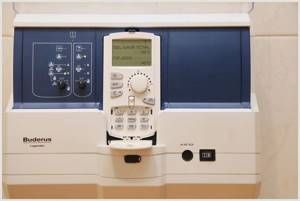
Modern automation is capable of:
- maintain different temperatures depending on the days of the week or time of day;
- regulate the thermal regime, taking into account weather conditions;
- create individual temperatures in individual rooms;
- prevent freezing of the heating circuit;
- diagnose faults and much more.
Automation design
All internal equipment of automation for gas boilers, which is used when installing a heating system, can be divided into categories, there are only two of them:
- the first category is those devices that ensure the safe and proper operation of all boiler equipment;
- the second category is those devices that can significantly increase the comfort when using the boiler.
Safety automation for gas boilers consists of the following elements:
- the module that provides flame control. It consists of a thermocouple and a gas valve that works like an electromagnetic valve and shuts off the fuel supply;
- there is also a device that protects the system from overheating and maintains the required temperature; this task is performed by the thermostat. It independently, if necessary, turns on or off the boiler at those moments when the temperature approaches the specified peak levels;
- the sensor that controls traction. This device works based on vibrations depending on how the position of the bimetallic plate changes. It, in turn, is connected to a gas valve, which stops the gas supply to the burner;
- there is also a safety valve, which can be responsible for discharging excess coolant (for example, air or water) in the circuit. Some manufacturers immediately provide an element that helps dump excess.
The devices included in the security system are divided into the following types:
- mechanical;
- and operating from a power source.
Automation provides the user with more comfortable functionality, which is additional:
- automatic ignition of the burner;
- flame intensity modulation;
- self-diagnostic functions.
But such functionality is not limited to the internal design of the models.
Some design features of the models include additions such as sending data and processing it by an electronic system on equipment equipped with controllers and microprocessors. Then the following situation occurs: based on the received data, the controller itself begins to adjust the commands that activate the machine’s system drives.
Mechanical automation of a gas boiler also requires detailed consideration.
- The gas valve is completely closed and the heating installation is inoperative.
- In order to start a mechanical gas boiler, the washer is squeezed out, allowing the fuel to start and opening the valve.
- The valve opened under the influence of the washer and gas flowed to the igniter.
- Ignition is in progress.
- After this, gradual heating of the thermocouple begins.
- The electric shut-off magnet is supplied with a voltage that ensures its open position so that fuel access is not blocked.
- Mechanical rotation of the washer regulates the required power of the gas heating device, and the fuel in the required volume and with the required pressure is supplied to the burner itself. The fuel ignites and the boiler unit begins to operate.
- And after that, this process is controlled by a thermostat.
Automatic safety and regulation
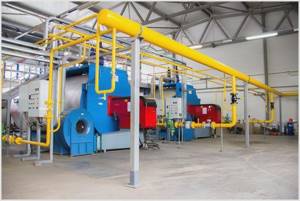
A mandatory component of the boiler room is safety and regulation automation. Our company provides professional installation and maintenance of automatic systems. If the burner goes out due to any deviations in the system, there is a danger of gas leakage and explosion. To avoid this, an automatic ignition system is needed that will start the burner or shut off the gas supply. Installing reliable automation is a task for professionals. Order this responsible work from experienced employees by contacting us.
The principle of operation of a gas boiler
This equipment operates according to an extremely simple scheme. Natural gas is mixed with air to form a fuel-air mixture that is ignited. The flame and hot products of fuel combustion heat the contents of a special tank - a heat exchanger, which is connected to a heating system (CO) with a liquid coolant.
The latter constantly circulates through the system - either only due to convection (natural circulation), or also due to the operation of a special pump (forced circulation).
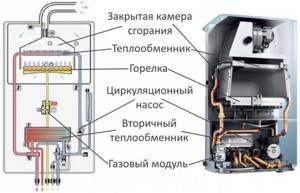
Installation of a wall-mounted double-circuit gas boiler
Flue gases, having given up part of their available energy to the coolant, are discharged outside through the chimney.
Along with conventional boilers, so-called condensing boilers are produced today. They “know how” to take more heat from the flue gases, so that they cool down to the condensation temperature of the water vapor they contain.
It is condensation that acts as the source of the main part of the additional heat (the processes of changing the state of aggregation are very energy-intensive). As a result, the efficiency of the installation increases to 97% - 98%.
Principle of operation
Operating principle of a solid fuel boiler
If in older models of solid fuel units, to regulate the air supply, it was necessary to open or close the ash door manually, and monitor the temperature visually using a thermometer, then in new boilers an automatic draft regulator is installed. This device is energy-dependent; its functions include opening and closing the ash pan damper depending on the temperature of the water in the container.
Taking into account the inaccuracy of the settings and the dependence of the operation of the unit on natural draft in the chimney, instead of an ineffective thermostat, a fan was installed to supply the required volume of air to the combustion chamber. And the operation of the fan is ensured by a controller that receives information about the state of the coolant from the sensor.
The controller consists of a screen and a control panel, designed to set the required coolant temperature. Models that do not have such a kit can be equipped with it; the fan is installed on the mounting plate, but you must first disconnect the ash door.
The coolant temperature is adjusted regardless of external conditions.
To maintain the temperature in the room taking into account street conditions, you can install an additional automatic system with an expanded range of capabilities: remote temperature controllers, outdoor air sensor.
Both wired and wireless methods are suitable for connecting them. Thanks to the information received from the sensors, the selected temperature regime in the house is maintained. This is the most rational method.
Safety valve
Modern automatic models have an ignition system, flame control, and continuous fuel supply. For ignition, an electric incandescent element is provided, which turns on after the pellet screw container is fed into the burner.
A stable flame, recorded by a photosensor in the form of a pulse transmitted to the controller, is a signal to turn off the electric ignition. During operation, granules are fed into the auger from a bunker, the volume of which is capable of providing heat to the room for several days, without human intervention.
Solid fuel units with an automatic control system, in addition to the above devices, are also equipped with safety devices, in particular, a safety valve.
It is necessary to discharge water from the boiler tank in case of overheating, to stabilize pressure, and also provides reliable protection of the casing from destruction. The boiler can be equipped with an overheating sensor, which signals if the temperature is exceeded at the initial stage.
So, boilers can be equipped with:
- Traction control sensor.
- Water level sensors in the jacket.
- Fan - smoke exhauster.
- Pressure recorders.
- Circulation pump.
- Fuel and water consumption sensor for domestic hot water.
- Sensors for the level of pellets or coal in the container.
All these devices are interconnected with a controller that performs control and signals emergency situations. The most sophisticated devices have a remote control function, where you can control automation via the Internet and mobile applications.
https://youtube.com/watch?v=a1lXt4mERHE
Electronics or mechanics
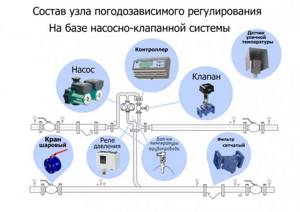
Modern boiler units, especially Western ones, are equipped with electronic boiler control systems, the cost of which reaches up to 30% of the total installation cost. The advantages of such a system are obvious; there is one drawback: it is afraid of unstable operation of Russian electrical networks. Therefore, it must be operated with reliable stabilizers and autonomous power supplies.
The range of regulation and control of the electronic system is practically unlimited: from pressure and temperature of the coolant to weather-dependent control of the heating unit.
In the safety system, the boiler will be turned off from the fuel supply at high/low gas pressure, torch separation, lack of vacuum in the furnace, low/high pressure and coolant temperature.
Mechanical actuators are also installed - a gas shut-off valve that is triggered by unacceptable gas pressure and a safety relief valve that protects the internal circuit of the boiler from high environmental pressure.
For example, the Buderus boiler unit is started by squeezing the gas valve washer, at the same time it opens and gas is supplied to the igniter. It heats up a thermocouple, which produces a current with enough voltage to drive an electromagnet to hold the valve open.
Next, the power of the boiler unit is set by the regulator, which allows gas to flow in the required volume with the operating pressure, and the heating process is controlled by a thermostat.
Operating principle of basic automation
Next, the machine turns on the gas burner, which picks up the fire from the igniter. After the coolant has warmed up to the required temperature, the automation (in this case the thermostat) switches off the burner, and when the water cools down to the limit values, a signal is given to turn it on. The igniter continues to burn all this time. This option allows you to:
- protect the surrounding area from possible gas leaks;
- prevent water from boiling in the heat exchanger;
- stop supplying fuel to the nozzle if there is no draft or a sudden change in gas pressure in the main pipeline.
System installation
All installation work begins after the project has been drawn up and approved by the relevant organizations. The technical specifications for the design are issued by the gas industry. The main requirements in it are for the room in which the boiler will be located.
Particular attention in the technical specifications is paid to general ventilation, the installation of chimneys, and the presence of gas analyzers. The distances from the walls when installing equipment are also regulated.
Connecting the boiler to the heating system.
It is necessary not only to study how the system works before purchasing it, but also to consult with specialists whether it is possible to install the unit in the intended location.
Where installation is possible
Despite the fact that it is recommended to install the AGV on the floor in a separate room, this does not exclude the possibility of installing such a boiler in the kitchen of a residential building or apartment, provided that the relevant requirements are met.
Wall-mounted gas boilers of this type are used very rarely, and even then after significant alterations, as a result of which their classification as traditional AGV is very conditional. Consulting with a specialist will help you choose the optimal location and type of boiler.
Pipeline layout
This type of heating system is open and is installed with overhead piping. Moreover, it can be single-pipe or double-pipe. Which one to choose is decided in each specific case individually.
Installing a two-pipe system allows you to turn off heating appliances using shut-off valves, but then the circulation resistance of the coolant increases sharply. Without the use of a pump, this can create problems during the operation of the heating system of an apartment or house.
Nuances of pipeline installation
During the installation of pipelines, an expansion tank is installed at the maximum possible height, which will accept the excess volume of water when it is heated. An overflow pipe is welded into it.
The diameter of the pipes for water supply and return drainage must be at least 50 mm. Such a significant increase in size is necessary to reduce the coolant resistance. They are installed with a slope to avoid air pockets.
Slope Options
The optimal slope is 1:100. The direction of the slope of the upper (supply) manifold is downward from the expansion tank to the first radiator. The lower (return) pipeline must have a slope from the last radiator to the AGV. Mayevsky taps are installed in the upper plugs of heating radiators, and the make-up tap is installed in the return line.
System layout.
Varieties
All equipment of an automatic gas water heater that controls the heating system modes can generally be divided into two main components. Moreover, the first group includes safety devices that are capable of maintaining the operation of the AGV in a given temperature range and ensuring the reliability of the system.
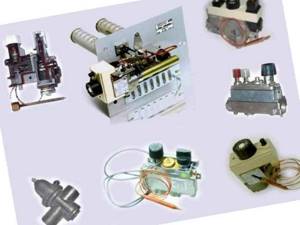
The second group includes automatic safety devices designed to ensure the most comfortable operation of the units. For example, a built-in electric ignition or an electronic thermometer is used for this purpose.
The mandatory list of safety automation systems used for gas boilers includes a regulated group of elements.
- A unit that controls the pilot flame. It should include automatic elements for gas units that have the ability to independently stop the gas supply.
- A unit that controls heating parameters of the coolant, capable of stopping heating when the maximum permissible level is reached.
- A module that controls draft, capable of interrupting the gas supply to the operating burner in the event of violations of the exhaust outlet.
- A safety valve that allows the release of excess pressure in the coolant.
If all the specified elements are present that ensure adjustment of the equipment of the existing gas boiler, the existing heating system is recognized as suitable for safe use and is allowed to operate. An entry about this is made in the automatic safety log of the water heating boiler.
The best manufacturers of boiler automation and safety systems
The best manufacturers of automation systems for household boilers on the Russian market are considered to be the following companies: Aries, Orion, Eurosit, Nech st24 wpa 120, Honeywell and Atos wpa 120.
Aries
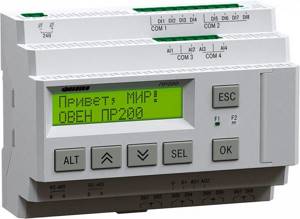
Automation for OWEN boilers operates using OWEN PLC controllers with TRM, which constitute a complex of protection and control of shut-off and control valves and valves, which ensures economical management of the fuel combustion process and energy efficiency of units, both single-circuit and double-circuit.
The devices are equipped with RS485/RS232 communication interfaces, allowing integration into a common automated system of several control and protection objects when operating on several heating boilers.
Orion
Automation "Orion" of mechanical type for gas fuel boilers. Equipped with an electric traction sensor and a piezoelectric ignition system. The boiler is protected in case of flame separation and low draft pressure. Automatic regulation occurs based on the low return coolant temperature parameter. In this case, based on a signal from the temperature sensor, the regulator valve increases the gas flow to the burner and, conversely, at a high water temperature in the heating circuit, the gas flow decreases.
Eurosit
Eurosit 630 is an Italian gas automatic for a boiler unit with a non-volatile valve, a modulation thermostat and a function for starting the burner device. It is put into operation manually by pressing the washer-regulator of the solenoid valve, after which the gas flows to the igniter.
After igniting the igniter, the temperature sensor creates a voltage sufficient to keep the valve open and reach operating power. The safety of the unit is ensured by cutting off the gas when the temperature of the coolant is exceeded, shutting off the gas to the torch, stopping the blower fan and the circulation pump.
Nech st24 wpa 120
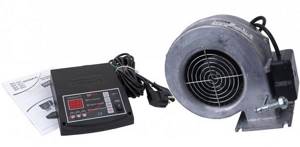
Polish automation for a group of solid fuel and gas boilers, complete with control of the operation of a blower fan and an electric circulation pump for an in-house heating system.
The control unit is installed on the boiler body. The controller sets the temperature of the internal air in the room, then the boiler of a private house operates in automatic mode, the actuators are a gas valve-regulator, a blower fan and a centrifugal pump.
The control panel has an LCD display with visualization of coolant heating processes and boiler operating parameters.
Honeywell
Automation made in Germany by Honeywell is considered the most reliable and efficient, capable of adjusting the coolant in the temperature range from 40 to 90 C. The boiler is protected according to the following parameters: low gas pressure, flame separation and low coolant temperature.
The price of the kit is very high, which reduces its attractiveness. Therefore, the manufacturer recently began to produce economy class equipment.
Atos wpa 120
Another Polish automation system, mainly included with the Tech ST-24 solid fuel boiler with WPA 120 fan.
The microprocessor controller monitors and controls the heating temperature of the supply coolant, the operation of the blower fan and circulation pump and signals an emergency situation during boiler operation.
The ATOS command controller for gas boilers has a built-in ANTI-STOP system, which supplies gas to the boiler in the summer and automatically turns it on every two weeks for 30-50 seconds to prevent corrosion processes and jamming of the centrifugal circulation pump.
Types of automation for heating boilers
The automation works properly, accurately and reliably, increases the efficiency of heating equipment, promotes reasonable consumption of energy resources and makes the operation of the heating system simple, comfortable and absolutely safe.
The automatic system protects heating installations from overloads and activates an emergency shutdown of the gas supply in the event of sudden force majeure circumstances. Additionally, the equipment regulates the level of combustion intensity and current fuel consumption, allowing owners to save money on heating the premises.
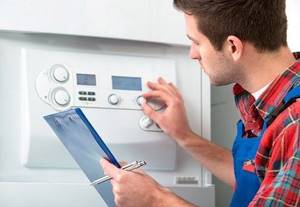
The automatic unit has flexible settings and allows the owner to set the most convenient operating parameters for the equipment.
Based on the basic operating principle and design features, automation for gas-powered equipment is divided into:
- energy dependent devices;
- energy-independent devices.
Systems of the first type are complex electronic units that require an uninterrupted electrical supply to operate correctly. The second types of devices are simplified mechanical structures that do not require energy supply.
Type #1 - volatile products
A volatile module is a small electronic device that responds to the supply of a fuel resource. It turns on and off when the main gas valve is activated or closed. It has a complex design and a large number of elements and microcircuits.
Allows owners to solve the following tasks:
- activation or termination of gas supply;
- starting the heating system in automatic mode;
- adjusting the power level of the base burner (due to the presence of a thermostat);
- turning off a running boiler both in emergency situations and within a user-specified mode;
- displaying current indicators on the display (the general level of air temperature in the room, the point to which the working coolant has been heated, etc.).
More sophisticated modules have additional functionality and offer users unlimited and most convenient conditions for monitoring the operation and control of the unit. Electronic panels provide full protection of heating equipment from malfunction of the three-way valve and prevent the boiler from freezing.
If the temperature in the room drops sharply, the “smart” system itself starts the heating equipment and turns it off when the home is filled with comfortable warm air.
The self-diagnosis option available for individual modules prevents operational failures and facilitates the timely identification of faulty parts and assemblies in the system. It makes it possible to notice a breakdown as early as possible and replace some small element even before it creates a real problem for the equipment.

Minor breakdowns of the heating system eventually turn into global complications and entail costs associated with the repair and dismantling (full or partial) of the equipment. Self-diagnosis helps to identify a malfunction and makes it possible to eliminate it in a timely manner.
Electronic automation, responsible for the safe operation of the equipment, ensures uninterrupted operation of the boiler, prevents the system from overheating and shuts off the gas supply in the event of a drop in draft or extinguishment of the flame in the burner.
The range of energy-dependent automation on the market today is pleasingly diverse. Useful and necessary mini-units are produced by world-famous brands and small companies that are just trying to earn their place in the sun.
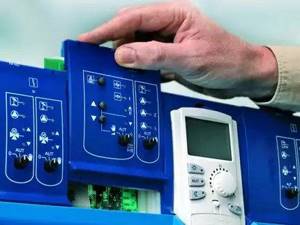
Volatile automation is presented in the form of a control panel, where the user can set convenient operating parameters for the equipment. The cost of a “smart” element is high, but the costs are justified, because with the help of a control unit you can reduce resource consumption without any damage to your own comfort
Among the models offered there are both very simple products and more advanced units with a programming option.
On them, the user can select the most suitable individual settings for himself and program the system to operate in day/night mode or, based on the weather forecast, set a certain level of heating of the house or apartment for a period of 1 to 7 days.
Type #2 - non-volatile units
Non-volatile automation is simpler and more practical. Control and adjustment are carried out manually using mechanical rotary toggle switches and are not difficult even for those who are far from technology. The device operates completely autonomously and does not need to be connected to a central electrical system.
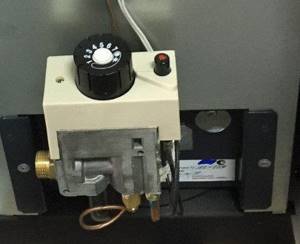
To heat a residential building and supply hot water to the taps, it is enough to turn the control knob in the direction of increase by 2-3 divisions. If you need to take a bath or shower, the toggle switch must be set to the maximum setting
The product is marked with a digital scale with a list of values from minimum to maximum. To activate, the user selects the desired mark and in this way sets the appropriate operating temperature directly to the boiler.
After these manipulations, the thermostat is connected and takes control of the specified heating mode. The boiler actively works until the room warms up to the desired temperature. Then the thermostat turns off the gas supply to the system and is activated again only when the room gets colder.
The operating principle is based on the specific design of the device. The gas boiler thermocouple built into the heat exchanger is equipped with a special rod. It is made from a special iron-nickel alloy called invar.
The physical characteristics of this advanced material give it the ability to almost instantly capture minimal temperature fluctuations.
If the room becomes too hot or too cold, the size of the rod changes. The connecting valve reacts to this and promptly shuts off or activates the flow of gas to the burner.
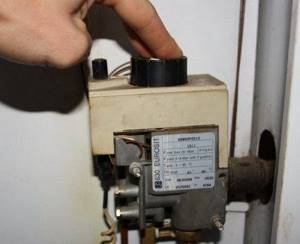
The presence of a non-volatile automatic control system allows users to set the most suitable temperature regime in their house or apartment and use fuel economically without overpaying on utility bills
Additionally, non-volatile automation has sensitive draft and flame sensors. If the pressure in the pipe suddenly decreases or the draft level in the chimney drops for some reason, the supply of the resource is immediately stopped and gas leakage can be avoided.
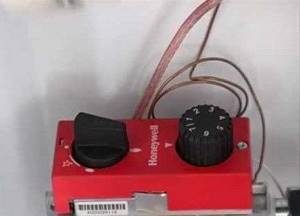
Non-volatile automation costs quite reasonable money and, unlike electronic analogues, does not require the purchase and installation of a stabilizer that controls voltage and equalizes unexpected surges in the central power grid
Correct operation of the flame sensor is ensured by a special plate. During normal and correct operation of the system, it is in a slightly curved state.
In this way, the part holds the shutoff valve in the “ Open ” mode. When the flame becomes smaller, the plate is leveled and the valve closes under its pressure.
Operating principle of the boiler
The connection diagram of the thermoelectric sensor in various gas-using devices is approximately the same. The measuring electrode is located in the area of action of the wick or the main burner, the conductor is connected to an electromagnet that opens the gas supply.
How does a thermocouple work on floor-standing boilers of the AOGV type and similar devices:
- The user presses the button with one hand and forcibly opens the gas supply solenoid valve.
- With the second hand, the homeowner turns on the piezo ignition while holding the first key. The pilot lights up.
- According to the operating instructions, the button must be held for 5-30 seconds (depending on the model of the unit), during which the wick warms up the measuring electrode.
- A direct current appears in the electromagnet circuit, coming from the thermoelectrodes. The user releases the key, but the fuel supply does not stop - the valve now holds the thermocouple voltage.

If, for various reasons, the fire goes out, heating of the thermoelement ends, and the EMF disappears. The electromagnet will turn off, the spring will close the valve and block the path of fuel.
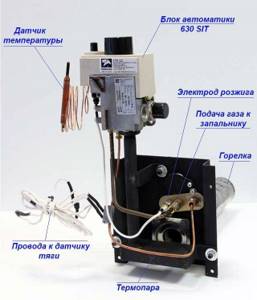
Disadvantages of the AGV heating system
Before choosing AGV heating, you should know that the system has several disadvantages:
- This system requires strict adherence to absolutely all pipeline layout rules.
- It does not provide for automatic adjustment and control of the temperature in each room separately. There is wasteful consumption of fuel.
If AGW is used at the dacha, then with the arrival of cold weather, if summer residents do not use the house in winter, they try to drain the water from the heating system. In order to avoid these manipulations, you can pour special antifreeze into the pipeline. Although you need to be extremely careful with this poisonous liquid.
Russian factories produce AOGV - 23.2 - 1. This is a household heating gas cylinder. It is intended for heating houses with an area of 140 - 200 square meters. meters. There is also a device with slightly less power for heating an area of 100 - 140 square meters. m. Otherwise, these two types of heaters are practically no different from each other.
Recently, a more modern model AKGV - 23.2 - 1 with a water circuit has appeared. It can also be used to heat a home and supply hot water. And instead of a pipe running inside the boiler, three steel sections are installed, which are made using a special stamping method and are hollow inside. The sections are mounted vertically and are connected into one chimney, through which gas combustion products flow into a separate chimney pipe.
Water is heated using a special coil, which encircles the entire circuit inside the boiler and the water that is used for everyday life flows through it. And in the boiler the water for heating is also heated. That is, it turns out that this device is two in one.
It completely controls the entire process of heating water. And the automation unit itself consists of:
- a temperature sensor that controls the water temperature;
- an electromagnet, which is responsible for controlling the main gas supply valve;
- thermocouple, which is mounted near the igniter. Heated by a constantly burning torch, it creates an electric current in the circuit;
- traction sensor. It is mounted in the chimney and controls the optimal draft of the pipe.
The automation unit will not allow you to turn on the heating of the AOGV if even the slightest breakdown occurs or the indicator of the boiler’s efficient operation is lost. The main thing is to properly adjust the automation and then the equipment will serve for a long time.
After which they became quite widespread throughout the Soviet Union, and proved themselves to be good. That is, AGV heating in an apartment has been tested over decades of use in the private sector and fits quite well into modern life, especially after it has been modernized and improved.
It is only necessary to observe absolutely all precautions when working with this type of boiler, follow documents such as the AGV heating instructions, and not engage in amateur activities - and then it will serve faithfully for many years, bringing warmth and comfort to the house. Moreover, this heating system is quite economical and allows the use of boilers both for heating the room and for a source of hot water, which is also very convenient and economical, both in terms of saving money and saving space in the occupied room
And taking into account the automation of equipment operation, this entire system is safe and easy to manage. The only thing is, after choosing AGV heating and installing it, you need to configure the automation correctly and then you can sleep peacefully
Moreover, this heating system is quite economical and allows you to use boilers both for heating the room and for a source of hot water, which is also very convenient and economical, both in terms of saving money and saving space in the occupied room. And taking into account the automation of equipment operation, this entire system is safe and easy to manage. The only thing is, after choosing AGV heating and installing it, you need to configure the automation correctly and then you can sleep peacefully.
Add a comment
The operating principle of double-circuit gas boilers. The difference between modern AGVs and traditional analogues. Recommendations for choosing AGV for a private home
Owners of private houses are familiar with the abbreviation AGV firsthand. An autonomous gas boiler, invented in the middle of the last century, successfully solves the problem of heating in suburban construction.
Gas boiler for heating a private house
During the modernization process, gas boilers have acquired many improvements, thanks to which modern AGVs can significantly save energy consumption. What is the peculiarity of such heating systems and how to choose the best option, we will consider below.
Application of the SABC system
SABC automation is a pneumatic, direct-acting manometric system. It does not require an additional power source, so it can be used in non-volatile heating systems.
The SABC system is used to control gas and combined water heating boilers.
Read a review of domestic gas heating boilers from leading manufacturers here.
You will find information about the design and operating principle of pellet heating boilers at the link -
Also read about choosing a heating boiler for a sauna.
Automation for pump

Regulates the operation of the system, controlling many functions, such as, for example, pressure, water distribution.
For normal operation, the following components are required: a manifold that provides water supply, a relay that controls the pump, a pressure gauge that measures pressure, a dry-running sensor that prevents the device from overheating if the water runs out.
All automation responsible for the pump is divided into several models, based on the time of creation:
First generation automation;
The first simplest water supply design. Used to solve simple problems when it is necessary to provide a room with a source of water. It consists of three components: a dry running sensor, a hydraulic accumulator that performs the task of accumulating water and contains a membrane, and a relay that controls water pressure. It usually does not cause any difficulties during installation, since the system completely eliminates complex electrical circuits. The mechanism is also extremely easy: the order is cyclical—when the water is completely filled, the pump turns off, then the cycle repeats.
Third generation automation
It is a more worthy version of its predecessors, and costs more accordingly. The unit stands out for its greatest reliability, efficiency, improved safety program, and most importantly, maximum accuracy of the device.
To maintain the device in automatic mode, a relay is installed. The mechanism is simple: when the water pressure decreases, the relay starts the system, and similarly, when the pressure increases, it stops.
What is the operating principle of automation?
If we take into consideration the principle by which the device’s security system works, then an unambiguous conclusion will be drawn from this - the main points of the entire design are:
- safety valve;
- main valve
They are responsible for stopping the gas supply to the working chamber. They also open up fuel access. All automation for gas boilers is built on this principle.
The only difference is that there are functions that are additional to the operation of devices that are equipped with automatic adjustment.
That is, the device itself works due to the interaction of both valves.
You might be interested >> The operating principle of coaxial gas boilers
Basically, all systems operate according to the following scheme:
- The regulator is placed in the position necessary for the temperature to begin to rise for heating the room.
- A signal is sent to the sensor that the system is working.
- The shut-off and modeling valves begin to regulate the amount of fuel flow. As a result, the intensity with which the boiler heats up is established.
In order to understand how all these internal processes occur, it is necessary to consider the very design of the automation device for gas boilers.
It is better to dwell on this point in detail, because then the question of which boiler to choose for home gas heating will be more clear. It will also be possible to purchase the most effective model with a high safety threshold.
